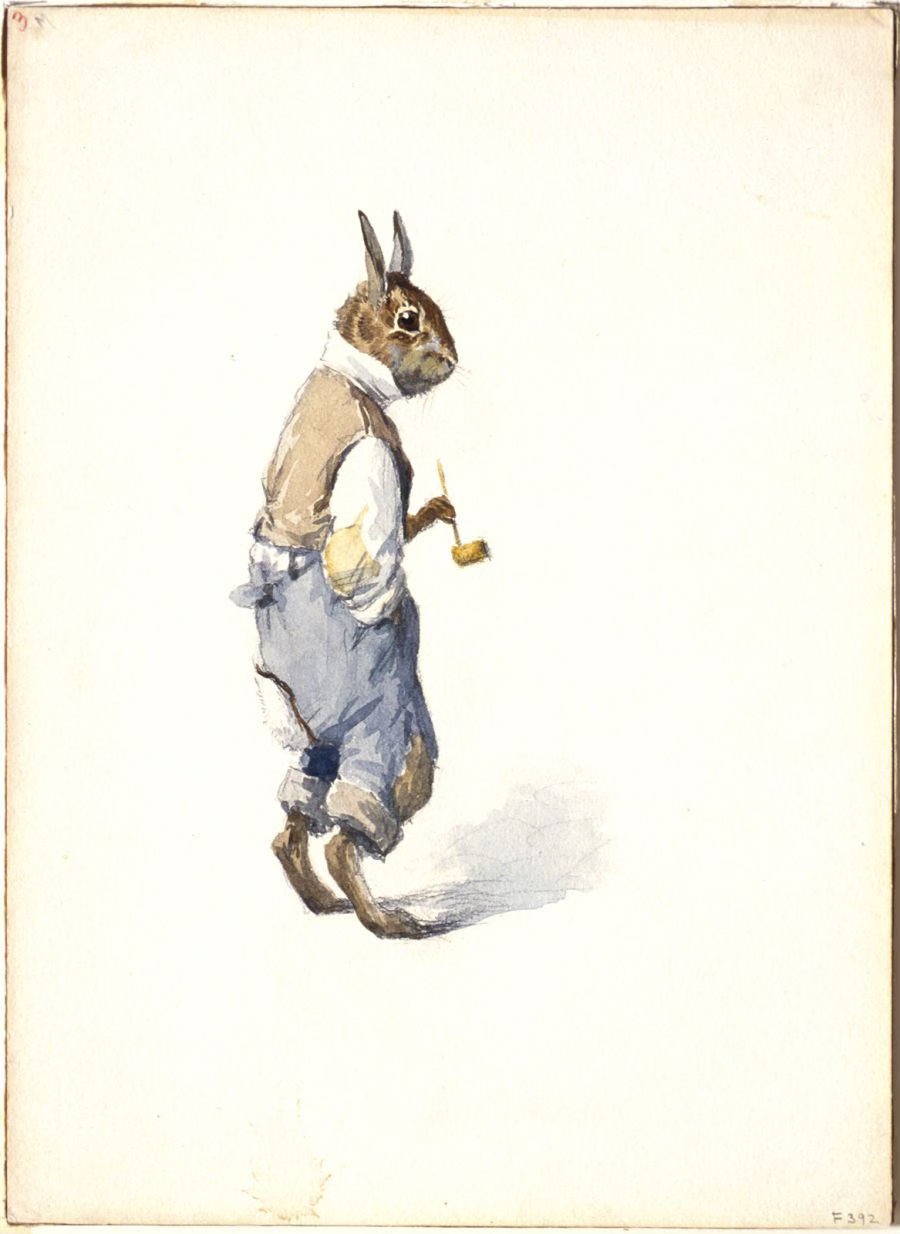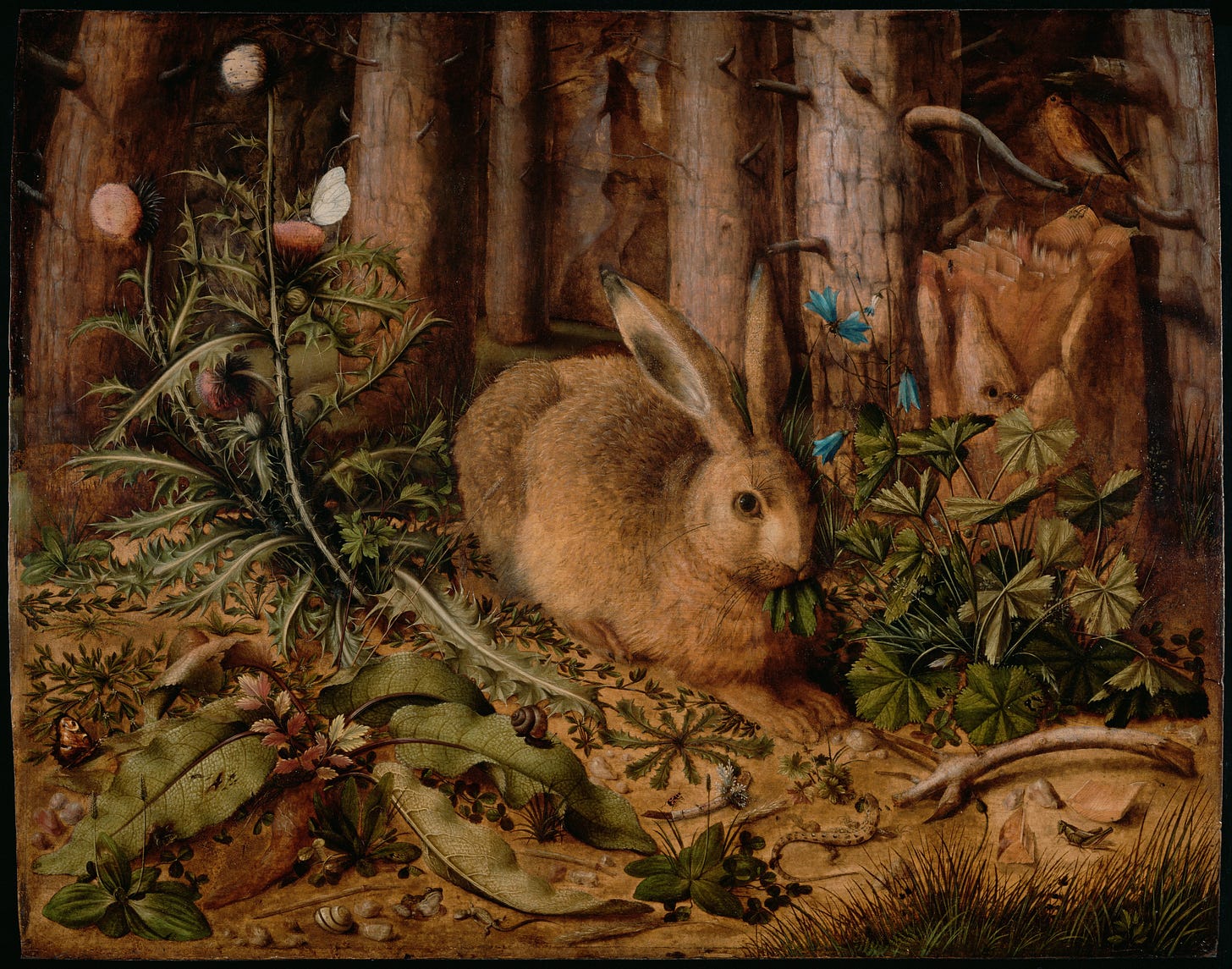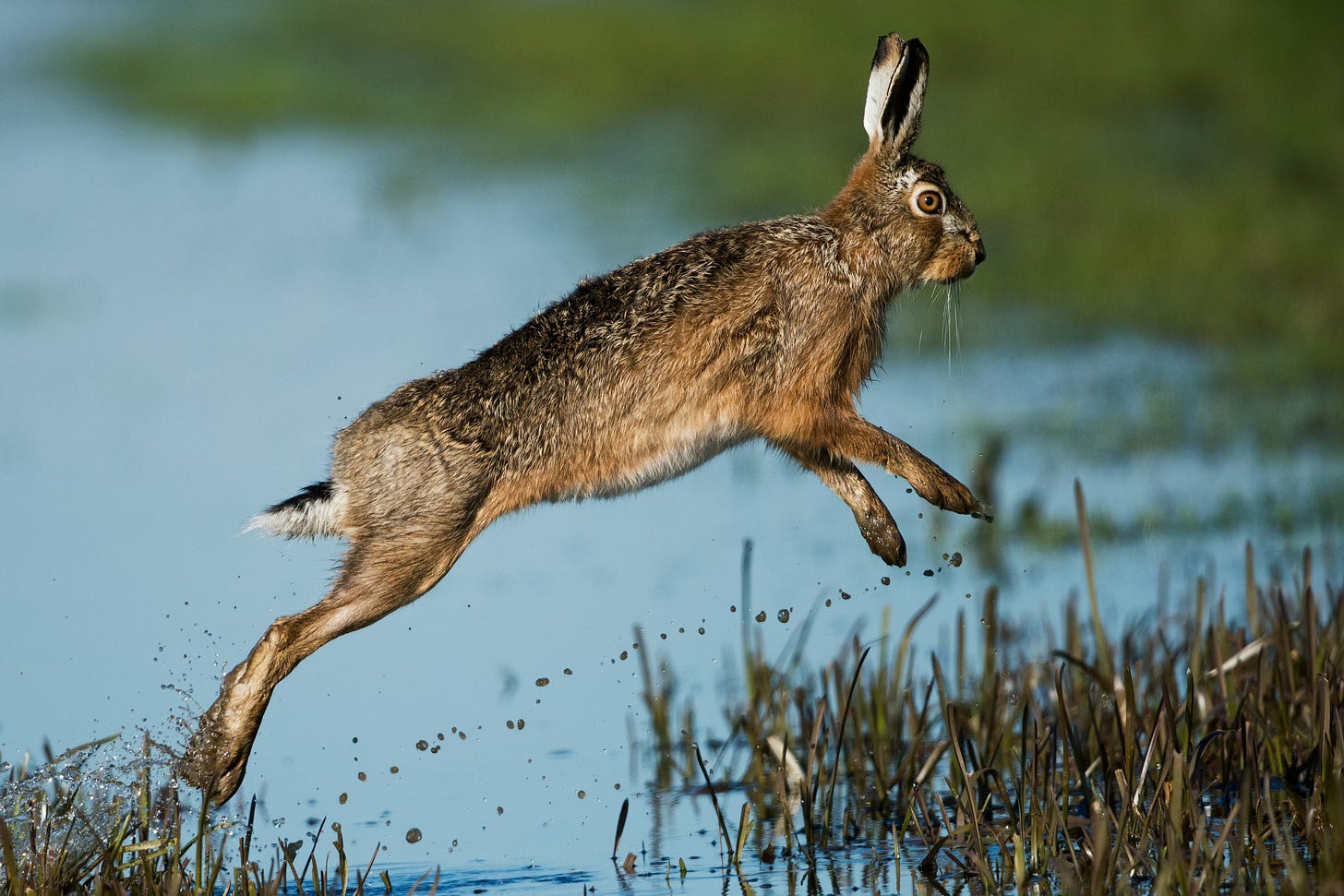Five rabbits & hares of folklore and a disgruntled special guest 🐇🪺
Someone is not a happy bunny...
Welcome to LOST IN FOLKLORE, where I take a lighthearted look at elements of folk stories, fairy tales, myths and monsters. If you’ve arrived here by accident and want to unsubscribe, please do. It helps make sure everyone on this quest wants to be here.
Oh, I did mention it’s a quest, right? Umm…forget I said anything.
Just watch out for the overtaking tortoise…
Hey there, Easter Bunny here. I’ll be your guide today.
No, I’m not one of the five, thanks for noticing. I’m not mad about it. It’s fine.
I mean, I did get my first official mention in text back in 1682, in Georg Franck von Franckenau’s De ovis paschalibus (On the Easter Eggs) but I suppose almost 350 years of fame makes me the nouveau riche of the mythology world, does it? *Sniff.*
So I don’t have enough gravitas for whoever’s organising this thing. Well, so what? Because who, at this time of year, is ubiquitous in every primary school, supermarket, garden centre and meme? Who are your kids asking for? And - more to the point - who delivers those delicious choclatey eggs on Easter Sunday, huh? It’s not that fricking moon rabbit from all the way from up there, is it?
NO. Do you not see my basket? It’s me. THE EASTER BUNNY.
Ahem. *Straightens tie; twitches tail* Anyway. I’ve been asked to introduce the following folk and that’s what I’m going to do. Because I am a professional. Even though most of these individuals didn’t even put on pants for the occasion. Whatever. Not my place to say.
Let us begin.
Br’er Rabbit

Okay so Br’er is wearing pants and carrying a pipe. But don’t let the sartorial choices fool you - this one is a Trickster with a capital T.
Arising from pre-colonial Africa, the Br’er stories and others like it were brought to North America by enslaved Africans. Collected somewhat controversially in the late 1870 by journalist Joel Chandler Harris, who as a young boy worked on a newspaper at a plantation, the Uncle Remus stories depicted a wise old freedman recounting tales of the wily Br’er Rabbit (Brother Rabbit), as well as Br'er Fox and Br'er Bear.
One of the best known Br’er Rabbit tales is The Tar Baby. One day Br’er Fox, who hated Br’er Rabbit, came up with a plan to capture and kill his nemesis. He created a baby made from tar and left it on the roadside. When Br’er Rabbit came along, he attempted to engage it in conversation but, hot tempered, when it didn’t reply he struck the tar baby, getting his paws and feet stuck. Br’er Fox emerged from the bushes, delighted that his plan had worked but Br’er Rabbit wasn’t out of tricks. As Br’er Fox listed all the horrible things he might do to his enemy, Brer Rabbit said: “Do whatever you please. Only please, Br’er Fox, please don’t throw me into the briar patch.”
Wanting to inflict maximum damage, Fox decided the briar patch was a delightful idea. But when he flung Br’er Rabbit in, anticipating his screams, he heard nothing but silence…until Rabbit popped up again, completely free. He was born and bred in the briar patch. Fox had played right into his hands! (I’ve got to say, that fox was rather a fool.)
There are some interesting and complex layers to the symbolism of this story. But does it deserve to be in the top five? I asked Br’er rabbit himself:
“Sorry EB, what are you waffling on about?" *Scratches ear*. “Honestly, I don’t care. In fact, only the dorkiest rabbits get included in listicles so please don’t include me. I’d hate that. Hey, spiffing tie you’ve got on there. Why don’t you put yourself in the list instead..?”
Ha! I put him in. That showed him.
Oh….wait…
Aesop’s Hare
Keen-eyed readers will recall that Lost in Folklore has featured an Aesop’s animal previously, in a Foxes of Folklore round up. But this time, our chosen creature is not the victor but the vanquished.
This particular fable, The Hare and the Tortoise, concerns an arrogant hare who was teasing the tortoise. “You’re so slow,” he said. “Do you ever even get anywhere?’” The implacable tortoise merely replied, “Yes, and I’ll give you a race to prove it.”
Of course the Hare (no pants! Just sayin’) leapt at the chance to humiliated the tortoise. And so, with the Fox acting as judge, the race was on!
Soon enough, the hare was so far ahead of the tortoise that he decided to take a nap, just to rub it in. And the tortoise plodded on, slowly making progress. Eventually the tortoise passed the hare, who was dreaming away, and by the time the hare awoke, the tortoise was at the finishing line. The hare couldn’t catch up and the tortoise won the race!
Moral: The race is not always to the swift.
Ahem. I mean…just checking, but does Aesop’s Hare really deserve a place in this list? Are we celebrating arrogance now, above the value of - naming no names - a certain dapper individual who brings joy and laughter to millions via the medium of egg-shaped confectionary? *Editors whisper in ear.* Oh right. Okay. Yes. We’re including this to convey an important moral lesson. Of course.
Got it.
Excessive pride is such an unattractive trait.
The Shapeshifter Hare

The Celts held the hare in high regard. (Clearly a very intelligent people.)
In their culture, hares were believed to be magical shapeshifters, associated with an unknown female hare goddess, and as such were revered.
The rabbit and hares’ rapid reproduction rate meant we swiftly became symbols of spring, fertility and abundance. And rabbit pie was firmly off the menu. Phew! As Julius Caesar wrote in Commentarii de Bello Gallico (Commentaries on the Gallic War): “The Britons consider it contrary to divine law to eat the hare…”
Instead, Iron Age Britons worshipped the hare, as shown by intact and carefully buried bones discovered by archeologists. Smithsonian Magazine confirms, “New research indicates that Iron Age Britons venerated brown hares and chickens long before modern Easter celebrations.”
Well exactly, as I tried to tell the editor, It’s not just my ears that are long and impressive. It’s my lineage too!
These links with the magical and supernatural have resulted in many fascinating folk stories. In one, originating from Ireland, poet and warrior Oisín was hunting one day when he accidentally shot a hare in the leg with his dart. When he chased the hare into the forest he discovered a fairy fort, and a beautiful young woman sitting on a throne, with blood dripping from her leg - the hare transformed into the fairy queen!
With that in mind, I shan’t quibble the Enchanted Hare’s place in this top five, if only because there’s a good chance one of the Lost in Folklore readers is a hare transformed into a beautiful young fae and I would hate to make an enemy of the fairy folk. Not after last time.
My basket has never quite recovered.
The Moon Rabbit
The Moon Rabbit is a feature of East Asian folklore. There are a few variations on this story but the Japanese legend goes that a moon god - the man in the moon - came down to earth, disguised as a beggar (as so often happens in folk tales - sneaky!) and asked a group of animals for some food.
Happy to help, the monkey collected fruit and the fox caught some fish but the rabbit had nothing to offer. So he asked the beggar to make a fire and then jumped into the flames, to offer himself. Yikes.
Because of the rabbit’s pure-hearted sacrifice, the beggar transformed back into a god and took the rabbit with him back to the moon.
And that is why, when you look at a full moon, it is said that you can see the shape of a rabbit, pounding with a mortar and pestle to make rice cakes. And the so called scientists who say that the shape visible on the surface of the moon is just volcanic basalt lava flows? They simply lack the magic to see.
I bet they don’t believe rabbits can lay chocolate eggs either. Can you imagine anyone being so foolish?
Nanabozho The Great Hare

Nanabozho is a hero from stories told by the people of the Ojibwe (also known as the Anishinaabe).
This Native American shapeshifter is another trickster, and appears in many folk stories, the best known of which is the Creation Myth, narrated here by Ningwakwe Learning Press:
As this story came from an oral tradition there are various versions, but the legend goes something like this:
The world was unbalanced and the creator decided to purify it by sending a great flood. Only the trickster hero Nanabozho and a few animals survived.
Nanabozo climbed onto a floating log, and spoke to the other animals, telling them that if they could dive into the depths of the water to find a piece of the old earth, he could use it to shape a new one. The animals agreed. First the loon tried, then the otter, then the beaver and then the mink. But the water was too deep. None could reach a piece of the old world.
Then muskrat offered to try. He was small and insignificant, but Nanabozho agreed to let him attempt it. The Muskrat dove beneath the water. He was gone for a long time, and the animals though all was lost. But then he emerged, clutching a piece of the old earth in his paws.
Then a turtle swam up and told Nanabozho to place the earth on his shell, he would bear the new earth. Nanabozo did so and, as the winds blew from the four directions, the earth began to grow until “A huge island sat in the middle of the water, and today that island is known as North America.”
Well. I won’t argue with this inclusion. It doesn't get much more impressive than creating a new earth does it? (Though carrying a heavy wicker basket full of eggs comes a close second.)
But…you know what goes nicely with world regeneration? Yes, that’s right - a nice pair of slacks and a bow tie.
Just a suggestion for next time. 🎀🐰
So there you have it - five rabbits and hares of folklore. I hope you enjoyed that round up and that you weren't too disappointed not to read more about yours truly. If you are just gagging to know more about me, you can read an article here.
And maybe if I bring the editor an extra large chocolate egg, she’ll devote a whole article to me next year.
Happy Easter!
I’ll see you in the garden.
Love, the Easter Bunny 🐰🪺
Enjoyed this post? Then you might also enjoy these other popular posts:







This is a lovely article! I've seen versions of some of these before, and I always love finding new fables and tales!
This was such a delightful read! 🐇